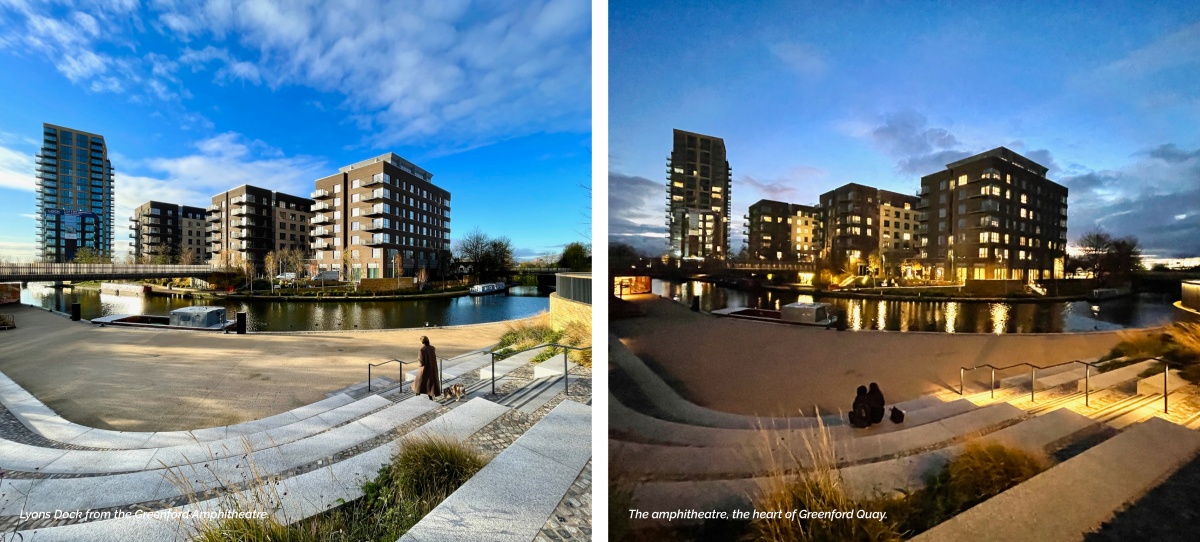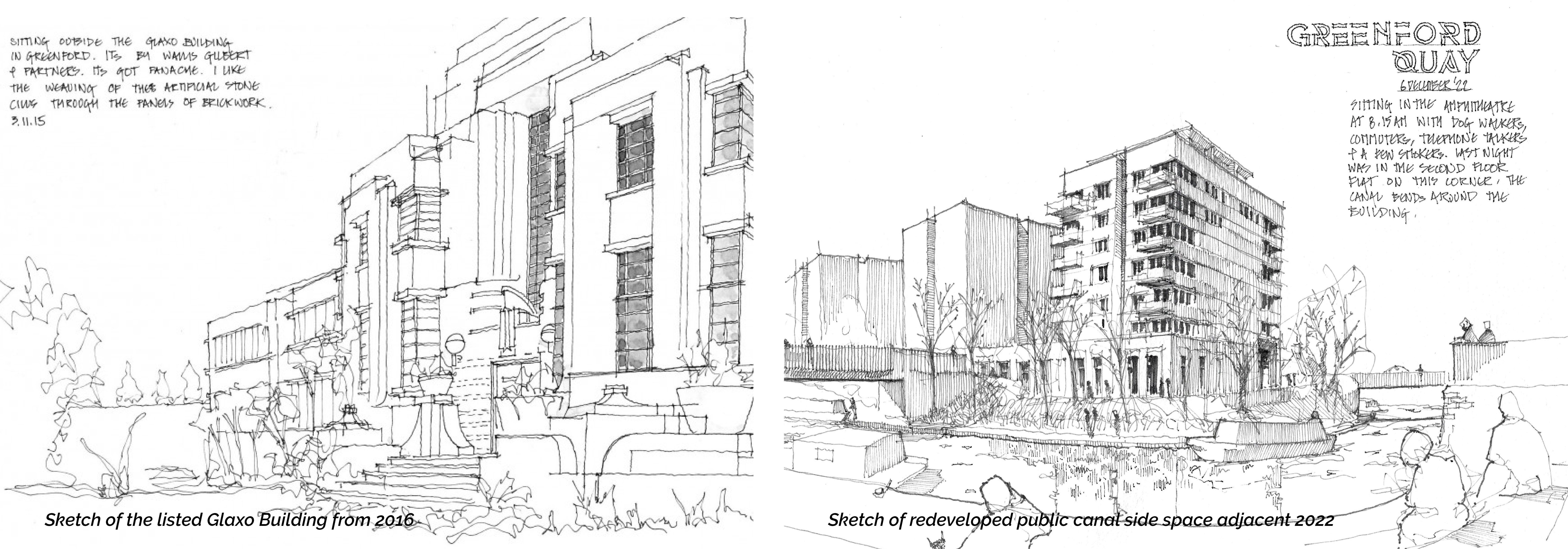An extract from Sandy’s reflections on time spent in a place he’d helped design:
I’m sitting in the amphitheatre at Greenford, finishing off a sketch of the building I’ve been staying in. You can see ‘my’ flat in the drawing: second floor, on the corner. When you’re in the livingroom, the canal boats sail down one side, turn, and then reappear on the other side. It’s a nice spot to watch life go by.
But the main focus of life is here, in this amphitheatre. It’s just before ten on a cold Tuesday morning and I’m surprised how busy it is. People, mostly women, bring their dogs down for a stroll along the canal. Lot’s of people do it, so they meet a familiar face or an even more familiar dog, have a brief chat and then off to face the rest of the day. The canal side is also an exercise track and a commuter route. A cyclist in full long distance Lycra pulls up, hops off, and smokes a cigarette in the morning sun. Engaging with the canal Coots that swim over looking for food, she doesn’t even look at her phone.
What makes a nice place to stop? It’s one of the questions I’ve given myself some time to answer. This popular space in the middle of Greenford Quay is the cultural as well as the physical heart, and I see it differently from the dog walkers and commuters who are my neighbours. You see, six years ago I was here when it was a very different place. Long abandoned factory and office buildings sat on either side of the canal. It was private land, fenced off from the surrounding neighbourhood as it had been for generations.

Our client, global Build to Rent provider Greystar, had the vision to buy not just one side of the canal, ambitious in itself, but both sides, creating the opportunity to do something truly memorable.
Over the following months we worked with Greystar on a masterplan for the place, opening it up to the public and building a new bridge to connect both canal banks. Multiple architects were involved as we reshaped the old listed buildings and designed a new vision for rented housing in London.
This amphitehatre came about as we had decided to keep the demolition material on site, but it took up a considerable amount of space. The north part of the site was about three metres above the canal edge, so Greystar’s answer was to use the demotlition materials to level the site and thus create a big drop to the water’s edge, which then became this south west facing space.
Now they use it for all sorts of events. In the summer there have been music concerts, comedy performances and football on a big screen. When nothing is on it’s a nice spot for residents and local neighbours to watch the canal boats gently navigate the river bend.

Over the last few years Greystar have built over 600 homes for rent, and Telford Homes have built another 300 for sale. It’s becoming a place. At HTA we are comnmitted to understanding what the people who live in the places we make really think about them. The term is ‘Post Occupancy Evaluation’ and it’s clearly a crucial area of study. HTA exists to make places where people want to live.
We must try hard to find out what that is. We have many sources. Resident surveys, client feedback, the views shared on Homeviews.com. Alongside this in depth research we believe there’s a place for the personal view, the immediate reaction that comes from experiencing life somewhere first hand.
So I’m staying here, in Lyons Dock, Greystar’s second rental building. Over the course of this week three of my colleagues will also stay, giving us a broader insight. I’m only here for a night and the two days either side, but I feel very lucky to have been given the chance. For one thing, the rental apartment is the thing that earns the money at Greystar. Lyons Dock is almost completely full, so occupying a flat that could otherwise be earning is a privilege. The other thing is that this just doesn’t happen all that much. Designers make homes for people but they seldom stay in them themselves. They show up on sites to discuss material choices or deal with issues or direct photographers, but they rarely actually just go and stay there: work, sleep, eat, chat, relax, socialize: live.

Since I arrived I’ve interviewed the on site management, played pool in the top floor lounge, worked in the co working spaces and hung out in the local cafes. I sketch and that’s a bit unusual, so people stop for a chat. I’ve done some formal interviews. Even on a short stay, there’s so much information to take away that it’s hard to process. For me, there are more pointers to the things I’d like to focus on in Greystar designs in the future than there are clear lessons to learn. It provides inspiration rather than revealing a recipe to follow.
There are some themes though. People love the apartments. They’re refined. Before we built anything, we built a prototype. We learned lessons from that and built 379 homes in the first building. They’re good, but there’s always room for improvement so we refined them and built another 250 in Lyons Dock. The apartments are all built in factories off site: everything is high quality and precision made, within a budget

One resident I interviewed, Kofi, told me how much he loved his flat. He’d prefer if it was in the city, where he works, but otherwise no complaints. He’d change the amenity though. Amenity spaces are a big deal in build to rent: ‘sleep in your flat: live in your building’ is the industry wide saying. Some Build to Rent providers have taken the approach of minimizing the apartments to pay for the amenity. Greystar haven’t done that. The apartments are generous, well beyond statutory sizes and in Kofi’s view that makes them so nice people don’t really leave them. But he’d like to. He’s here for what he describes as “the WeWork buzz ... when WeWork was good”. He understands that most people live, most of the time, in their beautiful apartment but he thinks there are enough people who want to live more communally that one central set of amenities, shared by all the blocks, could make a super local hub for the 2,500 or so people who will be renting here when the place is complete. Pumped up facilities you’d happily leave your front door for, rather than the building by building approach we’ve gone for here.

I ask him a few questions about the building design itself. It’s full of things the London rules outlaw. There are north facing single aspect flats. On a single floor, once you leave the lift, you can access 45 apartments. In Tillermans, where Kofi lives, 379 apartments are accessed through the same front door. He’s happy enough with all these things. Same story when I discuss them with the building management team. It’s these outlawed elements that let the building function. Without them there wouldn’t be the same level of amenity, the same size of apartment or at least not for the same rent. The buildings are lower, the places are nicer. It’s a different approach.
The London housing market is strengthened by accommodation like this. Everything doesn’t need to be the same and invention and new ways of solving problems that offer residents something genuinely different should be encouraged. Isambard Kingdom Brunel, as creative an engineer as England has ever known, criticised the constraints that legislators placed on his ability to create better solutions to the problems his era faced. He complained they “...shackle the progress of the improvements of tomorrow by recording and registering as law the prejudices and errors of today.”
Is that where we are headed with all the numerous poorly researched rules that prescribe almost every element of people’s homes?

I’ve finished the sketch. Behind me, the next building is under construction. In my short time here there are far more things to go away and consider than there are lessons to learn for the next project. However, some principles seem to emerge.
Firstly, everywhere needs a space that will come to characterise the place. At Greenford Quay it’s the amphitheatre. The space needs to emerge from the particular design constraints of the place but the characterful space is essential to creating a place people will be proud to call home.

Secondly, there’s room for many models of housing. Choice is good. Accept building arrangments that bring benefits to their occupiers. The prescriptions of professional designers don’t always resonate with the public who are living in the places we make.
And thirdly, with that gap between the designers and the residents in mind, get out there and take the time to talk to them about what we’ve made, how it works and how it makes them feel. Take every single chance.

Many thanks to Greystar for giving me and my colleagues this chance to learn a little bit more and provide the inspiration that fuels the design of places to come.

